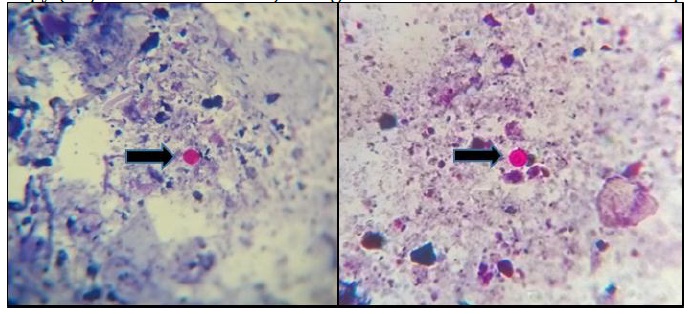Occurrence of Cryptosporidium spp. and its association with ponderal development and diarrhea episodes in nellore mixed breed cattle
DOI:
https://doi.org/10.21708/avb.2019.13.1.7977Resumen
Due to the increasing importance of cryptosporidiosis in animal productivity, this study was carried out to investigate the occurrence of Cryptosporidium spp. and its association with animal weight development and fecal consistency in crossbred Nellore cattle. Thus, fecal samples of 30 cattle were collected biweekly, and their growth was accompanied by weighing animals from birth to 210 days of age (June 2014 to May 2015). The modified Ritchie and Ziehl-Neelsen techniques were used to screen for the presence of Cryptosporidium spp. oocysts. The chi-square, Fisher exact, Tukey and Spearman’s correlation tests were used for statistical analysis. Oocysts of Cryptosporidium spp. were found in 69 (16.43%) of the 420 samples of cattle feces, and these parasitized animals presented a mean weight gain (4.76 kg) lower than that of non-parasitized individuals (10.58 kg) (p<0.05). The presence of this protozoan was detected in diarrhea and pasty stools (81.78%), indicating an association of the parasite with persistent diarrheal episodes (p<0.001). Among the bovines examined in this study, a higher occurrence of Cryptosporidium spp. was observed in lean diarrheic calves, which presented lower weight gain and poor productive performance.
Descargas

Descargas
Publicado
Número
Sección
Licencia
Autores que publicam na Acta Veterinaria Brasilica concordam com os seguintes termos: a) Autores mantém os direitos autorais e concedem à revista o direito de primeira publicação, com o trabalho simultaneamente licenciado sob a Licença Creative Commons Attribution que permite o compartilhamento do trabalho com reconhecimento da autoria e publicação inicial nesta revista. b) Autores têm autorização para assumir contratos adicionais separadamente, para distribuição não-exclusiva da versão do trabalho publicada nesta revista (ex.: publicar em repositório institucional ou como capítulo de livro), com reconhecimento de autoria e publicação inicial nesta revista. c) Autores têm permissão e são estimulados a publicar e distribuir seu trabalho online (ex.: em repositórios institucionais ou na sua página pessoal) a qualquer ponto antes ou durante o processo editorial, já que isso pode gerar alterações produtivas, bem como aumentar o impacto e a citação do trabalho publicado (Veja O Efeito do Acesso Livre).


 Esta obra está licenciada com uma Licença
Esta obra está licenciada com uma Licença 